2009 Seat Leon 5D ESP
[x] Cancel search: ESPPage 2 of 35

ForewordThis Instruction Manual and its corresponding supplements should be read carefully to familiarise yourself with
your vehicle.
Besides the regular care and maintenance of the vehicle, its correct handling will help preserve its value.
For safety reasons, note the information concerning accessories, modifications and parts changes.
If selling the vehicle, give all of the onboard documentation to the new owner, as it should be kept with the
vehicle.
Sist Comunicacion_EN.book Seite 1 Mittwoch, 15. Juli 2009 6:45 18
Page 6 of 35

Communication5
Controls and equipment
Controls and equipmentCommunicationIntroductionThis system allows you to connect your mobile phone to the
vehicle and to use the hands-free mode.The hands-free device means that the telephone can be used inside the
vehicle; the driver will not have to remove their hands from the steering wheel
nor will be distracted from traffic.
Note
•The voice command system is only available in the following languages:
Spanish, German, English, French, Italian and Czech. Other languages (such
as Dutch or Portuguese) will have Spanish as the default language for voice
instructions, and the vehicle must be taken to an Authorised Service Centre
for the change to be made.•There are certain versions of mobile telephone software that contain
errors. These errors may give rise to faulty operation of the vehicle hands-free
system. In this case, consult the Authorised Service Centre for your mobile
telephone.•Some mobile devices do not respond correctly to the orders of the keypad
in hands-free mode. Always use the vehicle controls to interact with the
mobile phone.
Sist Comunicacion_EN.book Seite 5 Mittwoch, 15. Juli 2009 6:45 18
Page 8 of 35

Communication7
Controls and equipmentsystem and can be displayed on the vehicle instrument panel. These
numbers may be selected using the multi-function steering wheel and calls
can be made using the multi-function steering wheel.
WARNING
•Please concentrate on driving. As the driver, you have the responsibility
for your safety and that of others. For this reason, you should only use the
functions in a manner that allows you to maintain control of the vehicle in
all situations - otherwise, you may create an accident risk!•The speech system must not be used in cases of emergency, since the
voice changes in stressful situations. This could result in a failed or delayed
telephone connection. Always dial emergency numbers manually!Note
•If your mobile phone allows you to store several numbers (home, mobile,
office..) under the same name or entry, they will all be listed as independent
entries on the instrument panel screen, but under the same name.•Depending on the mobile phone model, these entries will appear under
the same name with one different letter or character at the end. For example:
Antonio W, Antonio H, Antonio M.
Using the hands-free system from the steering wheel
The hands-free system can be used from the steering wheel.As well as using the voice command system, it is possible to use the functions
of the hands-free system from the controls on the steering wheel and the
radio.
When connection is established between your mobile telephone and the
hands-free device, the phonebook in your telephone and/or your SIM card
(depending on the phone) is downloaded to the hands-free device.
The phonebook may take up to four minutes to fully download to the commu-
nication system the first time the system is used. The download process is
indicated on the dash panel display.
Depending on the version, when the connection is established between your
mobile telephone and the hands-free device, the phonebook in the tele-
phone is downloaded to the hands-free device as well as lost calls, received
calls and last calls. From this moment, the phone book of the telephone as
well as lost calls, received calls and last calls are available on the screen of
the vehicle instrument panel.
Fig. 3 Agenda menu
depending on version
Sist Comunicacion_EN.book Seite 7 Mittwoch, 15. Juli 2009 6:45 18
Page 11 of 35
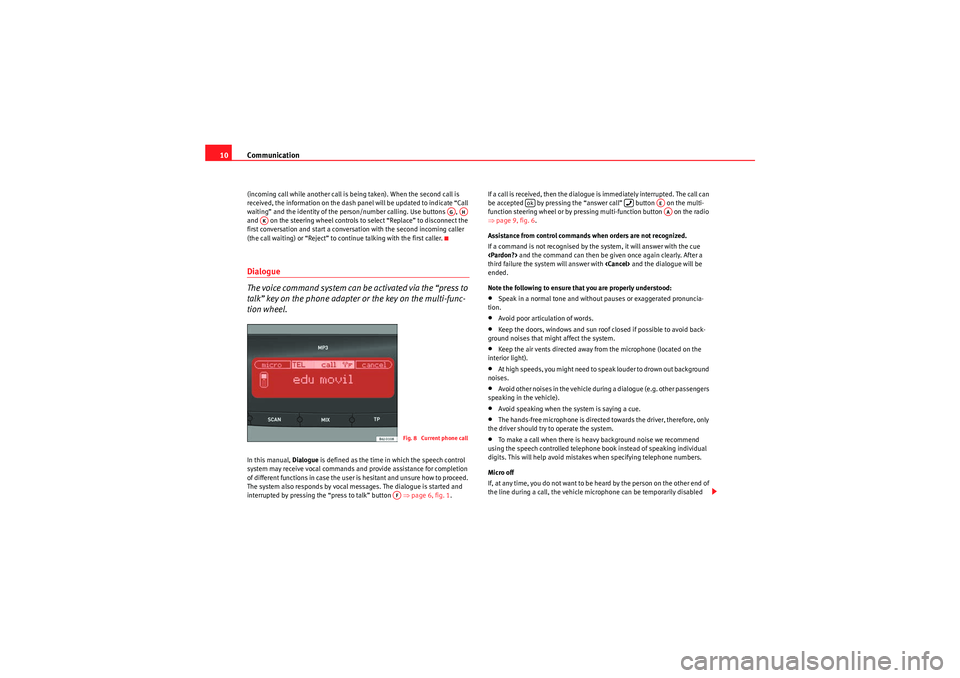
Communication
10(incoming call while another call is being taken). When the second call is
received, the information on the dash panel will be updated to indicate “Call
waiting” and the identity of the person/number calling. Use buttons ,
and on the steering wheel controls to select “Replace” to disconnect the
first conversation and start a conversation with the second incoming caller
(the call waiting) or “Reject” to continue talking with the first caller.Dialogue
The voice command system can be activated via the “press to
talk” key on the phone adapter or the key on the multi-func-
tion wheel.In this manual, Dialogue is defined as the time in which the speech control
system may receive vocal commands and provide assistance for completion
of different functions in case the user is hesitant and unsure how to proceed.
The system also responds by vocal messages. The dialogue is started and
interrupted by pressing the “press to talk” button ⇒page 6, fig. 1 .If a call is received, then the dialogue is immediately interrupted. The call can
be accepted by pressing the “answer call” button on the multi-
function steering wheel or by pressing multi-function button on the radio
⇒
page 9, fig. 6 .
Assistance from control commands when orders are not recognized.
If a command is not recognised by the system, it will answer with the cue
third failure the system will answer with
ended.
Note the following to ensure that you are properly understood:
•Speak in a normal tone and without pauses or exaggerated pronuncia-
tion.•Avoid poor articulation of words.•Keep the doors, windows and sun roof closed if possible to avoid back-
ground noises that might affect the system.•Keep the air vents directed away from the microphone (located on the
interior light).•At high speeds, you might need to speak louder to drown out background
noises.•Avoid other noises in the vehicle during a dialogue (e.g. other passengers
speaking in the vehicle).•Avoid speaking when the system is saying a cue.•The hands-free microphone is directed towards the driver, therefore, only
the driver should try to operate the system.•To make a call when there is heavy background noise we recommend
using the speech controlled telephone book instead of speaking individual
digits. This will help avoid mistakes when specifying telephone numbers.
Micro off
If, at any time, you do not want to be heard by the person on the other end of
the line during a call, the vehicle microphone can be temporarily disabled
AGAH
AK
Fig. 8 Current phone callAF
ok
AEAA
Sist Comunicacion_EN.book Seite 10 Mittwoch, 15. Juli 2009 6:45 18
Page 13 of 35
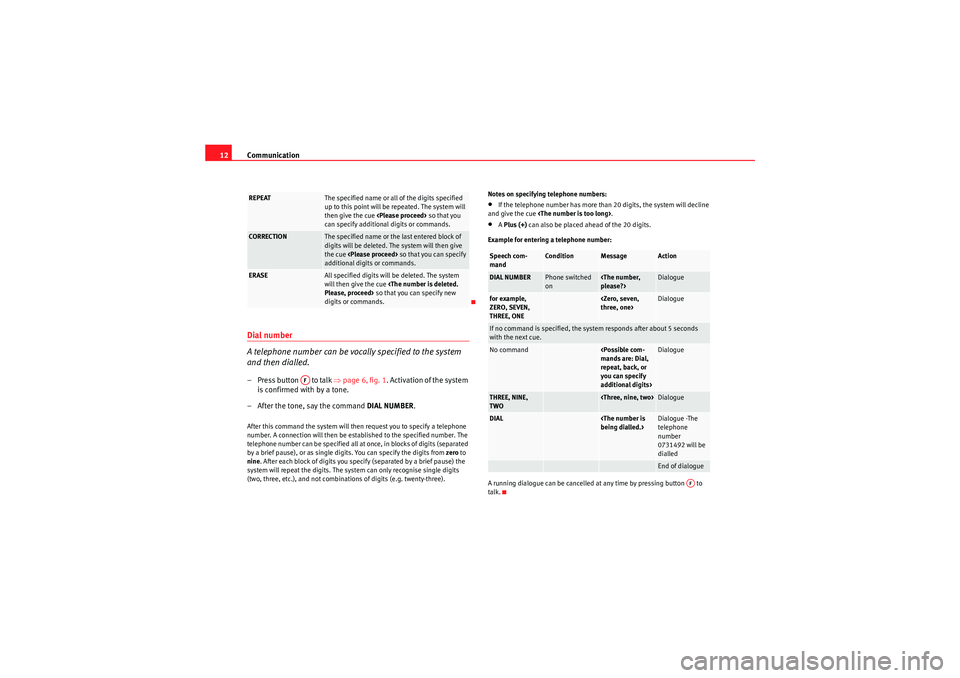
Communication
12Dial number
A telephone number can be vocally specified to the system
and then dialled.– Press button to talk ⇒page 6, fig. 1 . Activation of the system
is confirmed with by a tone.
– After the tone, say the command DIAL NUMBER.After this command the system will then request you to specify a telephone
number. A connection will then be established to the specified number. The
telephone number can be specified all at once, in blocks of digits (separated
by a brief pause), or as single digits. You can specify the digits from zero to
nine . After each block of digits you specify (separated by a brief pause) the
system will repeat the digits. The system can only recognise single digits
(two, three, etc.), and not combinations of digits (e.g. twenty-three). Notes on specifying telephone numbers:
•If the telephone number has more than 20 digits, the system will decline
and give the cue
Example for entering a telephone number:
A running dialogue can be cancelled at any time by pressing button to
talk.
REPEAT
The specified name or all of the digits specified
up to this point will be repeated. The system will
then give the cue
can specify additional digits or commands.
CORRECTION
The specified name or the last entered block of
digits will be deleted. The system will then give
the cue
additional digits or commands.
ERASE
All specified digits will be deleted. The system
will then give the cue
digits or commands.
AF
Speech com-
mand
Condition
Message
Action
DIAL NUMBER
Phone switched
on
Dialogue
for example,
ZERO, SEVEN,
THREE, ONE
Dialogue
If no command is specified, the system responds after about 5 seconds
with the next cue.No command
repeat, back, or
you can specify
additional digits>
Dialogue
THREE, NINE,
TWO
Dialogue
DIAL
Dialogue -The
telephone
number
0731492 will be
dialledEnd of dialogue
AF
Sist Comunicacion_EN.book Seite 12 Mittwoch, 15. Juli 2009 6:45 18
Page 14 of 35
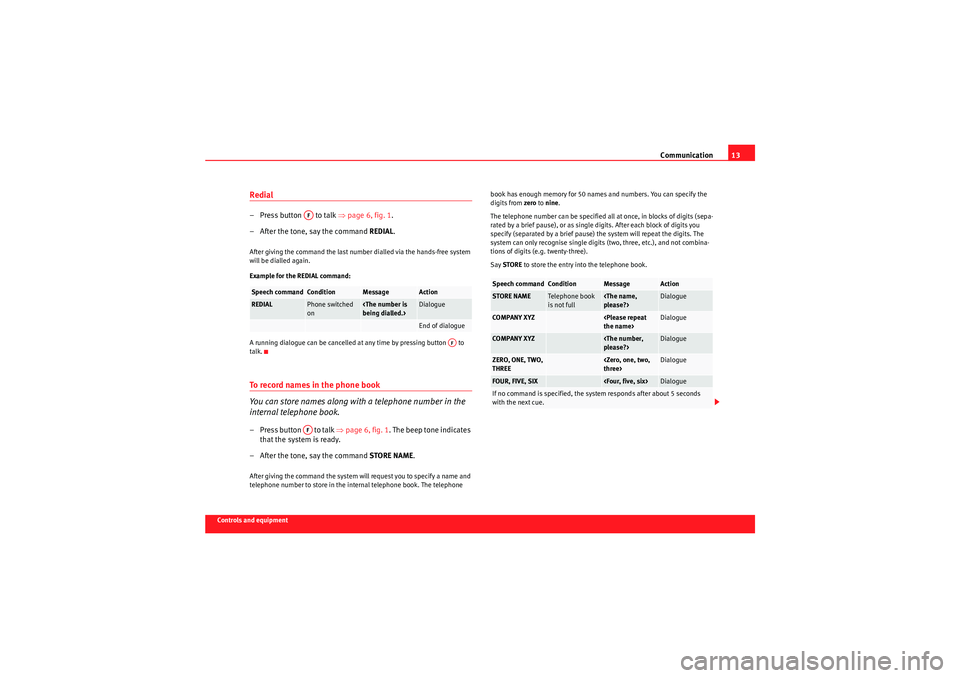
Communication13
Controls and equipment
Redial– Press button to talk ⇒page 6, fig. 1 .
– After the tone, say the command REDIAL.After giving the command the last number dialled via the hands-free system
will be dialled again.
Example for the REDIAL command:
A running dialogue can be cancelled at any time by pressing button to
talk.To record names in the phone book
You can store names along with a telephone number in the
internal telephone book.– Press button to talk ⇒page 6, fig. 1 . The beep tone indicates
that the system is ready.
– After the tone, say the command STORE NAME.After giving the command the system will request you to specify a name and
telephone number to store in the internal telephone book. The telephone book has enough memory for 50 names and numbers. You can specify the
digits from
zero to nine .
The telephone number can be specified all at once, in blocks of digits (sepa-
rated by a brief pause), or as single digits. After each block of digits you
specify (separated by a brief pause) the system will repeat the digits. The
system can only recognise single digits (two, three, etc.), and not combina-
tions of digits (e.g. twenty-three).
Say STORE to store the entry into the telephone book.Speech command
Condition
Message
Action
REDIAL
Phone switched
on
DialogueEnd of dialogue
AF
AF
AF
Speech command
Condition
Message
Action
STORE NAME
Tele pho ne bo ok
is not full
Dialogue
COMPANY XYZ
Dialogue
COMPANY XYZ
Dialogue
ZERO, ONE, TWO,
THREE
Dialogue
FOUR, FIVE, SIX
Dialogue
If no command is specified, the system responds after about 5 seconds
with the next cue.
Sist Comunicacion_EN.book Seite 13 Mittwoch, 15. Juli 2009 6:45 18
Page 15 of 35
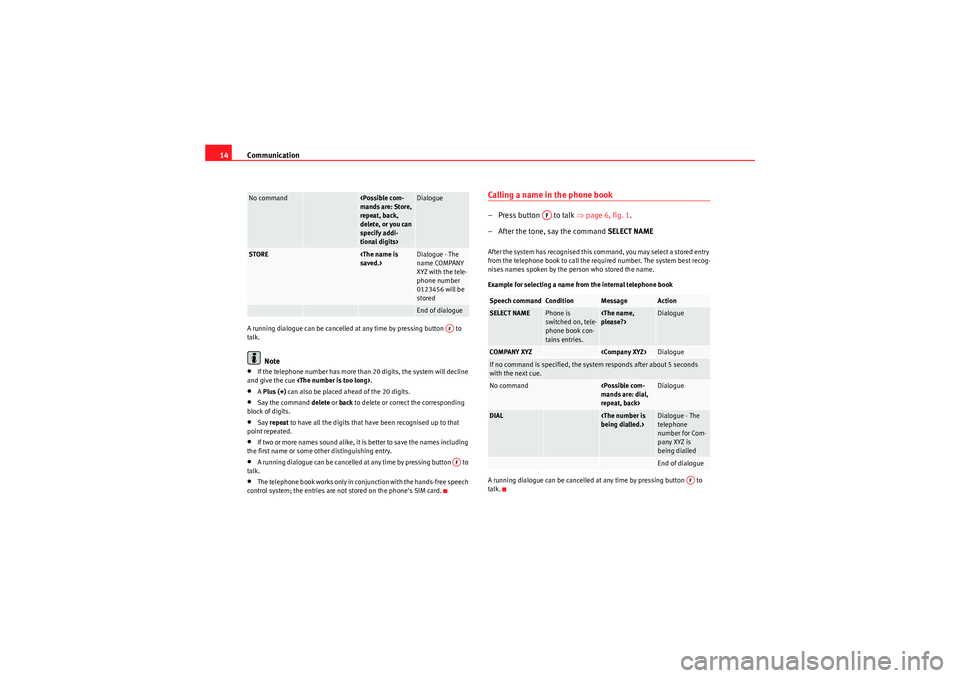
Communication
14A running dialogue can be cancelled at any time by pressing button to
talk.
Note
•If the telephone number has more than 20 digits, the system will decline
and give the cue
block of digits.•Say repeat to have all the digits that have been recognised up to that
point repeated.•If two or more names sound alike, it is better to save the names including
the first name or some other distinguishing entry.•A running dialogue can be cancelled at any time by pressing button to
talk.•The telephone book works only in conjunction with the hands-free speech
control system; the entries are not stored on the phone's SIM card.
Calling a name in the phone book–Press button to talk ⇒ page 6, fig. 1.
– After the tone, say the command SELECT NAMEAfter the system has recognised this command, you may select a stored entry
from the telephone book to call the required number. The system best recog-
nises names spoken by the person who stored the name.
Example for selecting a name from the internal telephone book
A running dialogue can be cancelled at any time by pressing button to
talk.
No command
repeat, back,
delete, or you can
specify addi-
tional digits>
Dialogue
STORE
Dialogue - The
name COMPANY
XYZ with the tele-
phone number
0123456 will be
storedEnd of dialogue
AFAF
Speech command
Condition
Message
Action
SELECT NAME
Phone is
switched on, tele-
phone book con-
tains entries.
Dialogue
COMPANY XYZ
Dialogue
If no command is specified, the system responds after about 5 seconds
with the next cue.No command
repeat, back>
Dialogue
DIAL
Dialogue - The
telephone
number for Com-
pany XYZ is
being dialledEnd of dialogue
AF
AF
Sist Comunicacion_EN.book Seite 14 Mittwoch, 15. Juli 2009 6:45 18
Page 16 of 35
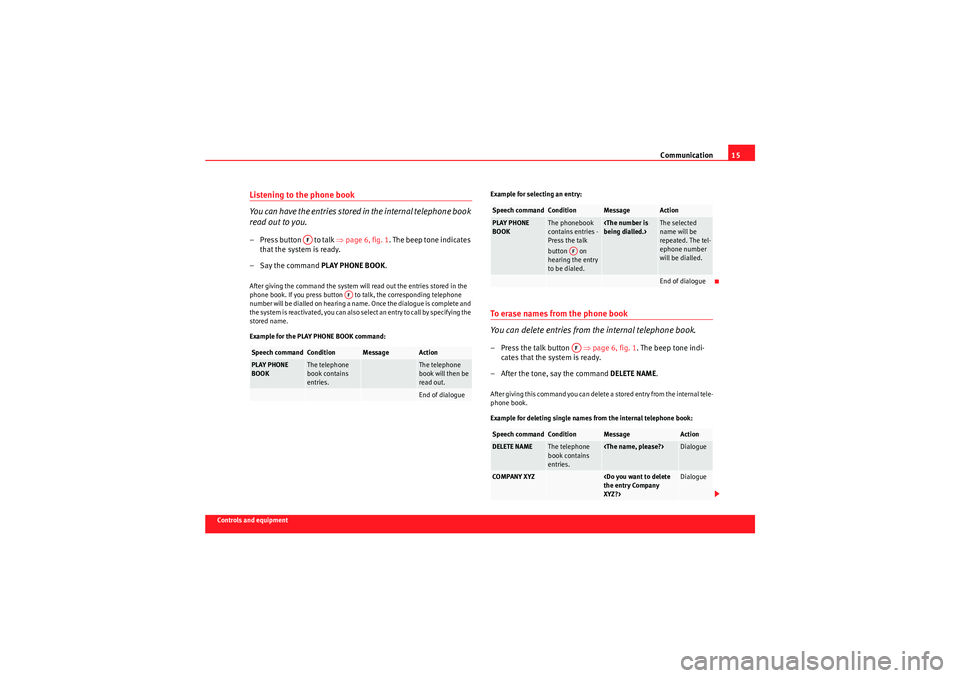
Communication15
Controls and equipment
Listening to the phone book
You can have the entries stored in the internal telephone book
read out to you.– Press button to talk ⇒page 6, fig. 1 . The beep tone indicates
that the system is ready.
– Say the command PLAY PHONE BOOK.After giving the command the system will read out the entries stored in the
phone book. If you press button to talk, the corresponding telephone
number will be dialled on hearing a name. Once the dialogue is complete and
t h e s y s t e m i s r e a c t i v a t e d , yo u ca n a ls o s e le c t a n e n t r y t o ca ll b y s p e c i f yi n g t h e
stored name.
Example for the PLAY PHONE BOOK command: Example for selecting an entry:
To erase names from the phone book
You can delete entries from the internal telephone book.– Press the talk button
⇒page 6, fig. 1 . The beep tone indi-
cates that the system is ready.
– After the tone, say the command DELETE NAME.After giving this command you can delete a stored entry from the internal tele-
phone book.
Example for deleting single names from the internal telephone book:
Speech command
Condition
Message
Action
PLAY PHONE
BOOK
The telephone
book contains
entries.
The telephone
book will then be
read out.End of dialogue
AF
AF
Speech command
Condition
Message
Action
PLAY PHONE
BOOK
The phonebook
contains entries -
Press the talk
button on
hearing the entry
to be dialed.
The selected
name will be
repeated. The tel-
ephone number
will be dialled.End of dialogue
Speech command
Condition
Message
Action
DELETE NAME
The telephone
book contains
entries.
Dialogue
COMPANY XYZ
XYZ?>
Dialogue
AFAF
Sist Comunicacion_EN.book Seite 15 Mittwoch, 15. Juli 2009 6:45 18